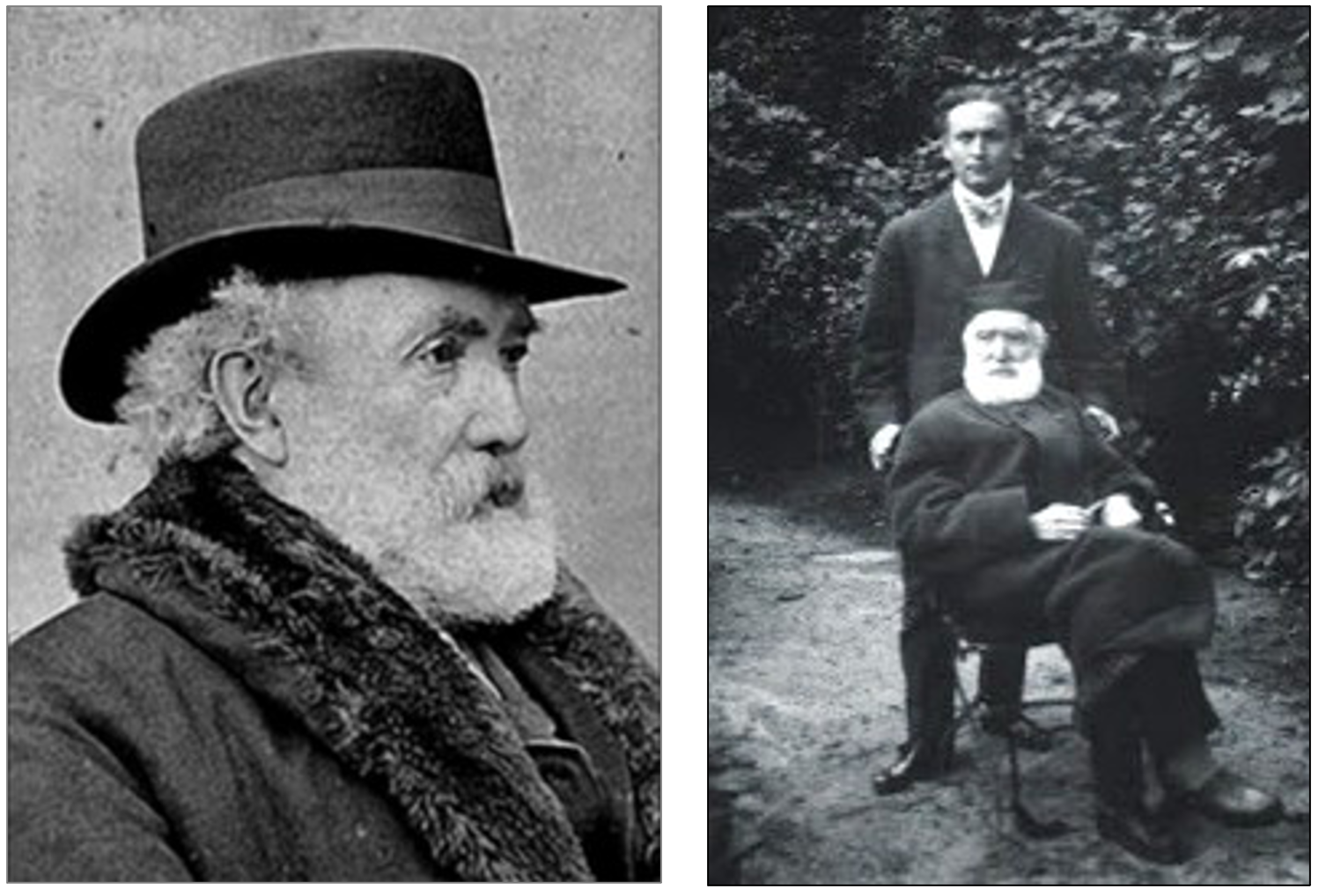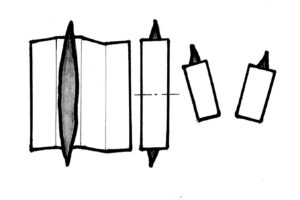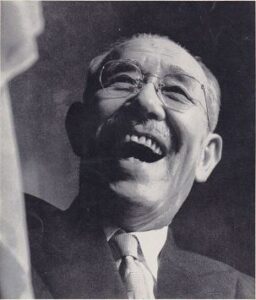“Sphinx Legacy” 編纂記 第21回
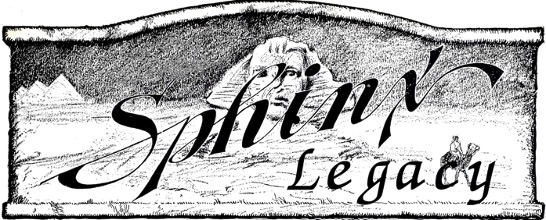 加藤英夫
加藤英夫
Houdiniはマジックの歴史の研究にも取り組み、”The Unmasking of Robert Houdin”を著述いたしました。今回は、Houdiniが同書に書いたことを出発点として、関連情報を集めてみました。
出典:”Sphinx”, 1917年3月号 執筆者: 不明
The following facts are taken from Harry Houdini’s literary masterpiece, “The Unmasking of Robert Houdin”.
The egg bag trick was performed by Richard Neve about 1715.
Fawkes, a magician, and Phillips, a contortionist, in 1728 gave two shows a night in London, the oldest evidence procurable of the original “Two a Night.” Fans bearing Fawkes’ picture and advertisement were distributed at Bartholomew Fair about 1728.
Alexander did the big bowl of water trick in America in 1845 long before Ching Ling Foo was ever heard of.
フレンチドロップの石田隆信氏のコラムに、‘Egg Bag’に関しての詳細にわたる歴史研究が書かれていますが、1715年のRichard Neveの情報は書かれていませんので、Houdiniの示した図解を引用しておきます。上記の記事には他のマジックに関しても記されていましたが、一部だけを引用いたしました。
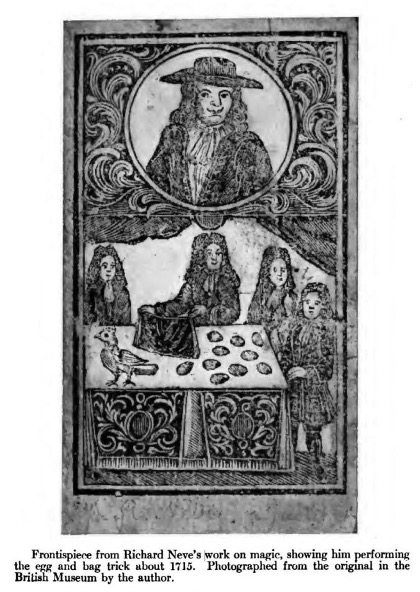
歴史研究においてある発見があったとき、その発見の裏付けになる追加情報を見つけることが定石であると思います。Neveの’Egg Bag’に関しては、上の図はHoudiniが何らかの書籍から引用したわけですから、何から引用したのか確認することにいたしました。
Richard Neveは”Arts Improvement” (1703年)、”The Merry Companion” (1716年)などの著者ですので、それら2冊を調べることにしました。それらをダウンロードすることはできませんでしたが、”University of London”のサイトで”The Merry Companion”を紹介していて、幸いなことに、唯一図解が掲載されていたのが、Neveが’Egg Bag’を演じているページでした。 同書についての紹介文も引用しておきます。
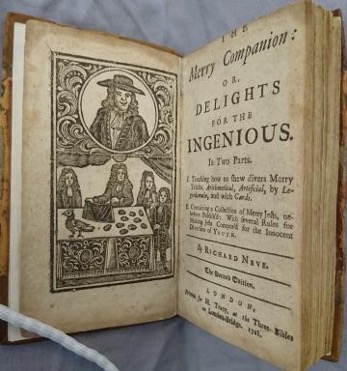
The Merry Companion is exactly that and one of the reasons why it is one of my favourite books in the Library. It’s an early example of conjuring tricks being promoted as a form of enjoyment and mental exercise for a young reader. Addressing the reader, the author states that his work is especially for schoolboys whose wits are best sharpened upon such whetstones, and long before the Victorian fashion for parlour magic, the book provides diversions to be enjoyed in the home, avoiding the ruin of seeking such amusements ‘abroad amongst ill company, first at the ale-house, then at the bawdy-house.’
Some of the ‘artificial tricks’ of the first section are more practical jokes, often at the expense of an unfortunate maid: adding soap to a butter churn so she may ‘churn until her eyes are out and never make butter’or adding chopped cat’s guts to freshly cooked meat to make it appear ‘magotty’. Among the tricks performed by legerdemain are turning water into wine and turning a grain of barley into as many ‘bushels as you please.’ But the book is particularly remarkable for the shuffles, passes and tricks described in the section on cards which includes a trick where a card chosen by a spectator thrown and stuck to the ceiling. The card is tracked using shuffling technique and soap is discreetly applied to hold in place once thrown. The card must be retrieved by the performer and the soap quickly removed ‘least another body do it, and so discover the trick.’
AlexanderがChing Ling Fooより先んじて、大きな水入り鉢のプロダクションをやっていた、ということに関しては、”The Unmasking of Robert Houdin”の中には、つぎのように書かれています。
A half page article in the New York Tribune, dated October, 1845, showed Alexander arrayed in a Chinese costume, and producing huge bowls of water, flowers, and various sorts of heavy articles. This proves conclusively that Ching Ling Foo was not the first conjurer to offer this Chinese trick in America, as it is generally supposed.
ここで指摘されているAlexanderとは、Alexander Herrmannでも、Ask AlexanderのAlexanderでもなく、Alexander Heimburger(1819-1909年)のことです。当書では原則として、1800年代に活躍したマジシャンを取り上げていませんが、上記の記事に関係あることと、その記事のソースとなったHoudiniと直接関係のあるマジシャンなので確認しておくことにいたしました。”magictricks.com”サイトではつぎのように紹介されています。
Alexander Heimburger was an exceptionally successful German illusionist who frequently was billed as “Alexander the Conjurer”. He enjoyed a brief but successful career that started in 1838 and included numerous tours of Europe, South America and the United States.
Heimburger was the first magician to be invited to perform for the President of the United States at the White House; that president was James Polk and the year was 1845.
The New York Tribune published an article about Heimburger, complete with a drawing of him in Chinese costume, producing large bowls of water. This was long before Ching Ling Foo made his reputation with the similar Goldfish Bowl trick.
P.T. Barnum approached Heimburger with an offer to appear in his dime museum, but Heimburger turned him down; Barnum was charging only 25 cents to see his entire show, while Heimburger was already charging and getting 50 cents admission to his show. (金額は1人あたりの入場料のことです)。
Samuel Morse also approached Heimburger with an offer to buy the secret of his famous Spirit Bell trick (the bell rang all by itself, as if by ghostly hand), believing that the secret had to be a scientific marvel rather than merely a magic trick. Heimburger was so financially successful that he was able to retire in 1854, at age 35.
Many years later, in 1903 and 1904, a young Harry Houdini spent time with Heimburger in Germany, listening to his stories and memories about his years in magic. Heimburger made such an impression on Houdini that he included the meetings in his book, “The Unmasking of Robert-Houdin”. Heimburger also gifted Houdini with many rare magic programs.
(つづく)

